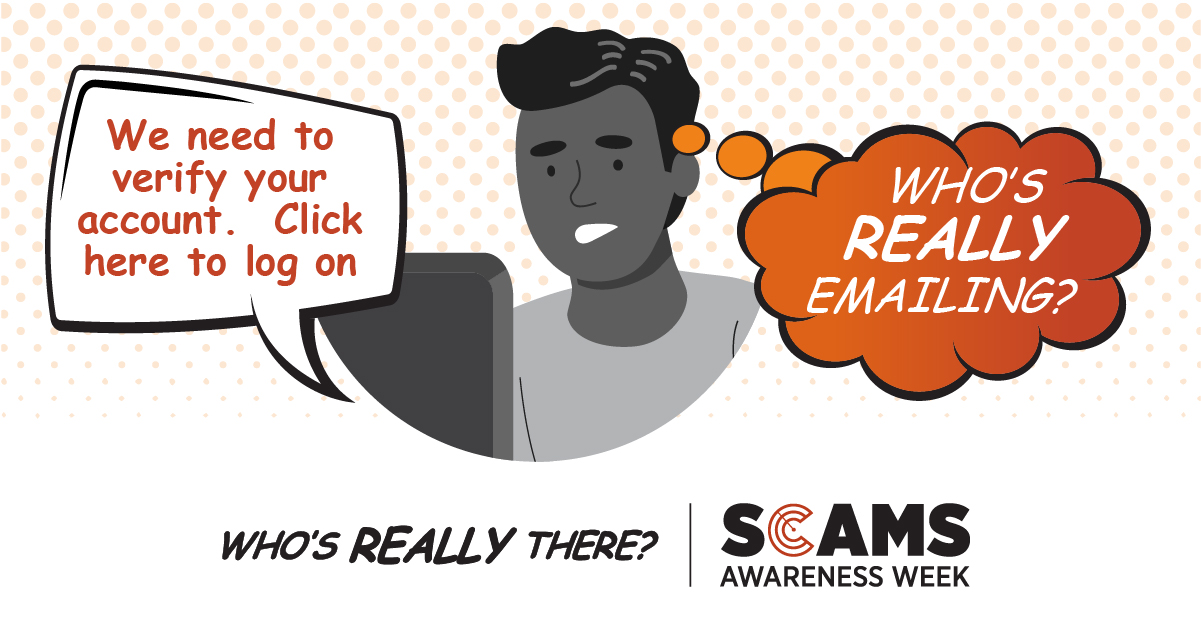Issued: 21 November 2023
Last modified: 21 November 2023

In 2022, scams cost Australian consumers, businesses, and the economy $3.1 billion and caused serious personal and emotional harm to victims and their families. With scammers continually developing new ways to deceive people, it’s important you stop and ask yourself ‘who’s really there?’
This year, Scams Awareness Week runs from 27 November to 1 December and it aims to highlight impersonation scams. You can do your part by not only protecting yourself, but also talking to your clients so they can be vigilant and protect themselves too. Impersonation scams can cause your business to suffer reputational damage or loss of revenue, not to mention the financial and emotional toll they can have on your clients. It’s therefore essential that you understand how to spot an impersonation scam.
What is an impersonation scam?
An impersonation scam is where scammers pretend to be trusted businesses, friends or family to steal your money or personal information. They often pretend to be government officials, well-known companies, law enforcement or even family and friends. They will contact you through text message, social media, phone calls, email and websites.
Methods of impersonation
Impersonation scams are becoming increasingly sophisticated, making them harder to identify. Some of the methods that scammers are using include:
- using technology to make their calls appear to come from a legitimate phone number
- making their text messages appear in the same conversation thread as genuine messages from an organisation
- replicating the websites of legitimate organisations to make them look like the real thing
- sending emails with fake sender addresses to appear to come from a trusted source
- creating fake social media profiles using another person or an organisation’s details and images
- forging documents to make you think you’re dealing with a real person or business.
Key signs of impersonation scams
Some of the key signs of an impersonation scam include:
- you receive a message that asks you to click on a link that takes you to a webpage asking for your username, password, or personal information
- you are asked to provide personal details or money urgently
- an organisation that you think is real, tells you there has been an unauthorised transaction or asks you to confirm a payment that you didn’t make
- a business asks you to use a different bank account and BSB from the last payment you made to them
- you’re contacted by someone saying they are from a government department or law enforcement, and they threaten you with immediate arrest, deportation, or ask you to pay money
- you’re asked to transfer money to an account to ‘keep it safe’ or for ‘further investigation’
- a sale, investment or job offer looks too good to be true.
How to stay safe
The best way to stay safe is to not automatically assume the person you are dealing with is who they say they are. Ask yourself ‘who’s really there?’ Don’t click on any links in text messages or open or download any attachments in an email. Opening any of these can install malicious software on your phone or computer giving the scammer access to your personal information, data and accounts. If someone threatens or intimidates you, cut contact with them immediately.
Verify who you’re dealing with
If you are contacted by someone and you’re not sure whether you’re dealing with a scammer you can:
- contact the person or organisation directly using contact details you’ve found yourself on the organisation’s official website
- access the organisations’ secure, authenticated portal or app (never via a link)
- watch out for slight variations in Caller or Sender IDs and website addresses like dots, special characters or numbers
- do online research of people and organisations who you’ve only dealt with online before paying any money – you can search the name online together with the word ‘scam’ to see if anything comes up.
If someone you know sends a message to say they have a new phone number, you should try to call them on the existing number you have or message them on the new number with a question only they would know the answer to. That way you will know if they are who they say they are.
Reporting impersonation scams
You can do your part to help stop scammers and warn others by reporting the scam to the National Anti-Scam Centre via Scamwatch. The information you provide helps the National Anti-Scam Centre identify the scams that are causing the most harm to Australians. You can remain anonymous or report on behalf of another person. If you provide consent, your information will be shared with law enforcement and other regulators in Australia and overseas to help them investigate and prosecute scammers.
If you believe you might have unwittingly shared sensitive information, divulged yours or your client’s tax file number or experienced a data breach, phone the Australian Taxation Office on 1800 008 540 to report it.
You can also contact the Australian Cyber Security Centre to report cybercrime.
Where to get help?
Being scammed is a horrible experience and it can happen to anyone. If you or your client need someone to talk to, you can contact Lifeline (13 11 14) or Beyond Blue (1300 224 636).
You can also contact IDCARE which is Australia and New Zealand’s national identity and cyber support service. They can help you or your client make a plan to limit the damage.